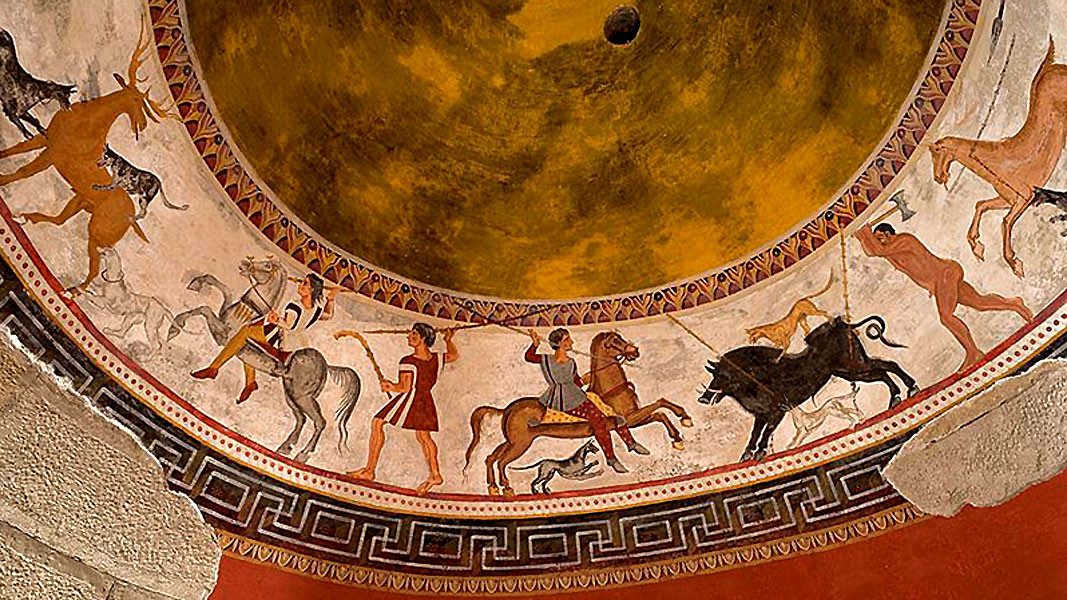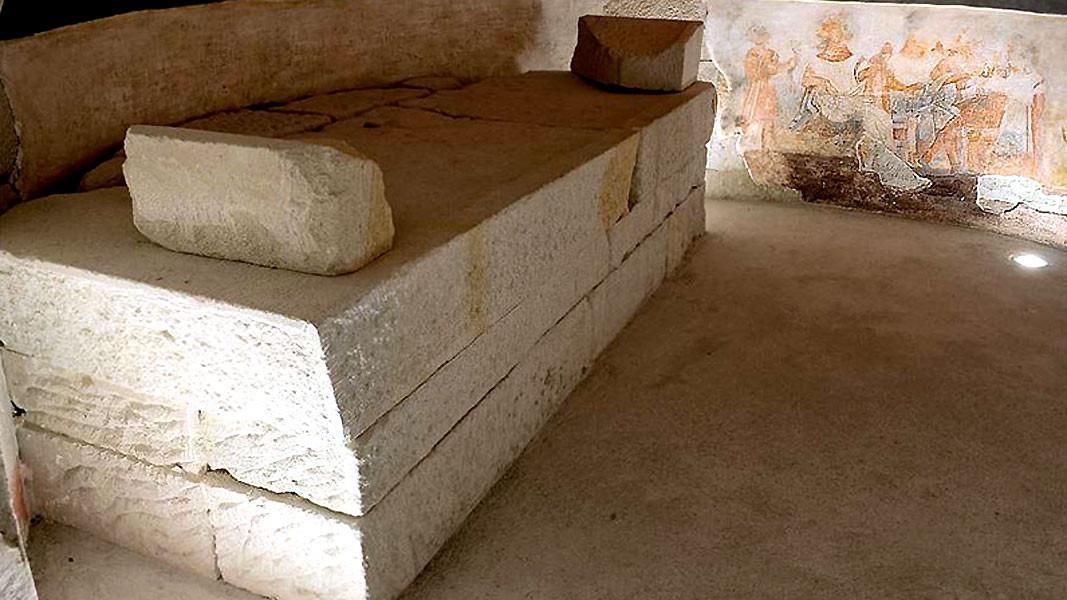In 2000 archaeologist Dr. Georgi Kitov and his team discovered, in the Roshava Chuka mound in the vicinity of Alexandrovo village near Haskovo, a Thracian tomb dated to the 4th century BC. The high artistic value of the frescoes and the architecture set it apart from all other monuments of the Thracian cultural heritage in the Bulgarian lands. It is also the biggest such building discovered in this country.
To preserve this monument of art and culture which was found plundered and partially destroyed by treasure hunters, a museum centre was built nearby – “Thracian art in the Eastern Rhodopes”. In 2011 it was put on the list of Bulgaria’s 100 national tourist sites.

It houses an exact “museum” replica of the tomb which, unlike the original, is open to tourists. To build the centre, the Japanese government made a donation of USD 3.5 million. The official opening on 15 May, 2009 was attended by Prince Akishino and his wife Princess Kiko themselves.
The tomb of Alexandrovo is a monument of culture of national significance and has been nominated for the UNESCO world cultural heritage list.

Penko Dobrev, director of the regional museum of history in Haskovo says that the copy of the tomb at the centre of the museum exposition replicates its architecture and decoration in full. There is just one difference – the 14-metre long corridor leading up to a rectangular and then to a round chamber is shorter. Both chambers are decorated with a variety of patterns and figures: animals, warriors, ornaments. The colours of the frescoes are just incredible:
“The pictures have been preserved in just two dome tombs – the Kazanluk and the Alexandrovo tomb,” Penko Dobrev says. “The one at Alexandrovo is bigger and the pictures depict scenes from the life of Thracians: their clothing, the way they hunted, their banquets, their battles, their burial rites. The drawings are not schematic as are all other drawings scattered around the Balkans. They convey unique information about the Thracians and that is what makes the tomb so valuable and unique. Above the picture of the profile of a young man there is an inscription – the letters may well be graffiti, but they could have been left by the author of the tomb. Experts say that the first word from the inscription – Kodzimases Hrestos – is a first name of Thracian origin and the second word is a sobriquet meaning capable, skilled artisan.”

The frescoes adorning the walls of the tomb of Alexandrovo make it a unique monument of Thracian art – a horseman and a foot soldier engaged in hand to hand combat, horses with harnesses depicted in incredible detail, a banquet with people at a table laden with different utensils made of silver and gold, hunters on horseback chasing after wild boar and deer. The scenes depicted even provide information about the weapons Thracians used, some of which unknown.
The frescoes in the round chamber are arranged in several belts of mural paintings and depict scenes from the life of the deceased ruler, who, Penko Dobrev says was comparatively young. His name is not known but he is thought to have been of noble lineage and with a high status.

At the museum centre, alongside the replica of the tomb of Alexandrovo, photos are on display of its opening and the study of details from the original frescoes. Each of the photographs go with a detailed explanation. There are various artefacts from the Iron Age, as well as:
“Mostly burial objects from the Thracian period – 5th-1st century BC,” Penko Dobrev explains. “A great many photographs present the Thracian culture typical of the Eastern Rhodopes. Besides Perperikon and Tatul, the so-called megalithic culture is also represented, a culture that is older. The idea is to show everything connected with the practices of the people living in the region of southeastern Bulgaria. Visitors can see the oldest gold, dated to 4,500-4,000 BC. It is among the world’s earliest processed gold and it was found in the region of Sakar Mountain. The fine workmanship of the gold objects can easily compete with the items from the Varna chalcolithic necropolis, which too are thought to be the oldest technologically processed gold in the world, dated to the 4th millennium BC.”
Photos: haskovomuseum.com
The house of Vasil Levski, Bulgaria’s national hero and organizer of the anti-Ottoman movement in the 19th c. has always been one of the most visited memorial museums in this country. The building itself is modest and its style is typical for..
In Bulgaria’s Northwestern corner a fantastic rocky landscape meets the eye – the towering Belogradchik rocks inspire awe and deference in any onlooker. The area is studded with yawning abysses, canyons and caves, gateways to the kingdom of..
“On 17 August 986 the warriors of Samuel smashed up on this spot the Byzantine invaders of Emperor Basil II. Glory forever!” These are the words engraved on a stone plate, placed at the Trayanovi Vrata (Gate of Trajan) fortress, situated some 60 km to..

+359 2 9336 661
